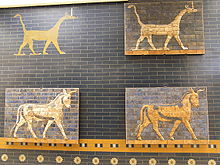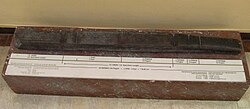Istanbul Archaeological Museum
The Istanbul Archaeological Museum ( Turkish İstanbul Arkeoloji Müzesi ) was founded in 1891 as the central archaeological museum of the Ottoman Empire in Constantinople and is now the largest and most important archaeological museum in Turkey .
Its collections include around 15,000 archaeological pieces from Mesopotamia , from the Assyrian , Sumerian , Akkadian , Babylonian and Egyptian antiquity, from prehistoric, Greek, Roman and Byzantine Asia Minor , as well as from pre-Islamic and Islamic Arab cultures.
structure
The Istanbul Archeology Museum is divided into three parts:
- The actual archaeological museum,
- the museum for ancient oriental art,
- the Museum of Islamic Ceramics ( Çinili Köşk )
location
The archaeological museum is located in Istanbul's old town, in the Eminönü district in the extreme southeast of the European part of Istanbul - on a peninsula protruding like a horn , within the outer wall of the Topkapı Palace , surrounded by Gülhane Park - below Hagia Sophia .
history
The museum was founded in 1891 under Sultan Abdülhamid II by the painter and archaeologist Osman Hamdi Bey as Müze-i Humayun ("Museum of the Empire") as the central archaeological museum of the Ottoman Empire. The architect Alexandre Vallaury built the building in the neoclassical style (construction started in 1881).
The part of the museum's collection with art from Istanbul goes back in part to a cataloging and recording project initiated by the then museum director Halil Edhem Eldem , which was carried out from January to the beginning of November 1918 with the collaboration of Friedrich Schrader and several important Turkish art historians and building experts at the time the rescue and preservation of Istanbul monuments and archaeological artefacts threatened by the effects of war and vandalism. The then owner of the photo studio Sebah and Joaillier , Hagop Iskender , was part of the team as a photographer .
The museum received the Council of Europe Museum Prize in 1991 .
- Directors
- Osman Hamdi Bey (1891-1910)
- Halil Edhem Eldem (1910-1931)
- Aziz Ogan (1931-1953)
- Alpay Pasinli (–2009)
- Zeynep Kızıltan (since 2009)
Collections
The pieces in the museum come from the entire Ottoman Empire, today they are still enriched by finds from Istanbul and its surroundings. The building is two-story. On the ground floor there are 20 exhibition rooms, on the upper floor there are 16 additional rooms showing smaller objects and sculptures from the Middle Ages and modern times. A new six-story outbuilding is located southeast of the main building.
Archaeological Museum
"Alexander Sarcophagus"
(Hall 8) The most famous single object in the museum is the so-called Alexander sarcophagus from the 4th century BC. BC, which was excavated in Sidon (Lebanon) in 1887 by the museum's founder Osman Hamdi Bey .
Other important objects
- Room 3: Sidamara - sarcophagus (3rd century), discovered in Konya in 1950
- Room 10: Phoenician inscriptions from Sidon and human-shaped sarcophagi
- Room 13: Lioness (4th century BC) from the Mausoleum of Halicarnassus
- Room 18: Colossal statue of Zeus
- (Upper floor) Bronze goods from Cyprus , Greek vases and coins. Among other things, objects from Troy VII b (for example drinking cups with a horizontal and a vertical handle)
- Head of the Serpent Column from the Hippodrome in central Istanbul.
New wing
On one level each, it contains exhibition rooms on the subjects of "Istanbul through the ages", "Anatolia and Troy through the ages", "Cultures in the vicinity of Anatolia (Cyprus, Syria, Palestine)" and a children's museum.
The ancient oriental museum


Diagonally across from the archaeological museum is the Ancient Near Eastern Museum with finds from areas of the Ancient Orient that belonged to the Ottoman Empire, especially from Mesopotamia (cultures of the Sumerians , Babylonians , Assyrians etc.) and Asia Minor, here for example the kingdom of the Hittites . Other exhibits come from Syria / Lebanon / Palestine, Yemen ( Old South Arabia ) and Pharaonic Egypt .
The building was built in 1883 as an art school and rededicated to this museum in 1935.
The internationally well-known exhibits include Hittite cuneiform tablets from Boğazkale , including one of the three surviving Hittite copies of the peace treaty between Hattušili III after the Battle of Kadesh . (Hittite Empire) and Ramses II (Egypt). These tablets have been included in the UNESCO World Document Heritage , as they contain the oldest surviving written peace treaty in human history.
The ancient oriental museum in Istanbul also houses the specimen of the nippur cubit , the original measure of the pre-metric length measures .
The Çinili Köşk
The museum's collection of Islamic ceramics is housed in Çinili Köşk and shows Seljuk and Ottoman ceramics from the 12th to the 19th centuries from various places of origin ( Kütahya , Çanakkale ). Various works of art made of faience tiles from the Iznik workshops occupy a special room . The most important exhibit is a mihrab from the Ibrahim Bey Mosque in Karaman (Central Anatolia) as well as two arches from the madrasah of the Haseki Hürrem Mosque in Istanbul.
The building was erected in 1472 by Sultan Mehmed II outside the Topkapi palace district as a pleasure palace and equipped inside and outside with mosaics made of green and blue Iznik tiles. The representative portico replaced a wooden porch after a fire in 1737.
literature
- Gustave Mendel: Catalog des sculptures grecques, romaines et byzantines. Musées Imperiaux Ottomans .. . 3 volumes. Constantinople 1908–1914, OCLC 489938917 (still an indispensable standard catalog ).
- An illustrated guide to the Greek, Roman and Byzantine architectural and sculptural collections in The Archaeological Museum of Istanbul. Istanbul 1968, OCLC 117856 .
Web links
- Museum website ( Memento from October 4, 2015 in the Internet Archive )
- Ministry of Culture website
- City website
- almost 1300 photographs of exhibits in the museum
Individual evidence
- ^ Friedrich Schrader: The art monuments of Constantinople. Der Neue Orient 5 (1919), pp. 302–304 and 352–354
- ↑ 1965 to 1974 it was closed for restoration work.
Coordinates: 41 ° 0 ′ 41 ″ N , 28 ° 58 ′ 53 ″ E




